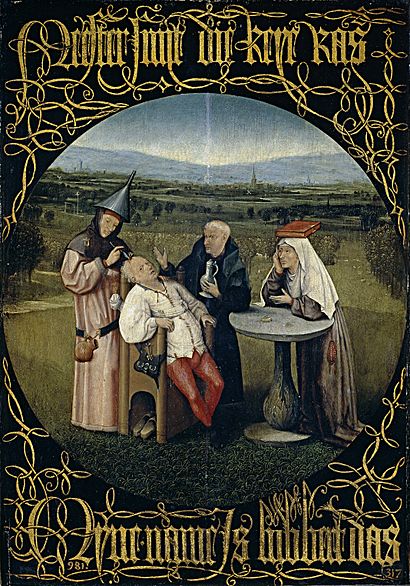Cutting the Stone facts for kids
Quick facts for kids Cutting the Stone |
|
|---|---|
 |
|
| Artist | Hieronymus Bosch |
| Year | c. 1494 or later |
| Type | Oil on board |
| Dimensions | 48 cm × 35 cm (19 in × 14 in) |
| Location | Museo del Prado, Madrid |
Cutting the Stone, also known as The Extraction of the Stone of Madness or The Cure of Folly, is a famous painting by the artist Hieronymus Bosch. It is displayed in the Museo del Prado in Madrid, Spain. Bosch finished this painting around the year 1494 or a bit later.
Contents
What is "Cutting the Stone"?
This painting shows a very unusual scene. It looks like a doctor is performing a strange operation on someone's head. The painting is a great example of Bosch's unique and often puzzling style.
What's Happening in the Painting?
The painting shows a "surgeon" wearing a strange funnel-shaped hat. He is trying to remove something from a patient's head. This old medical practice was called trepanation. People in the past sometimes believed that mental illness was caused by a "stone of madness" stuck inside the head.
An assistant, who looks like a monk, stands nearby holding a large drink. A woman with a book balanced on her head watches the scene.
The Strange "Stone"
What the surgeon is removing isn't a real stone. It looks like a flower bulb! This is a clever joke by Bosch. In Dutch, the word kei can mean both "stone" and "bulb." So, the "stone of madness" is shown as a plant bulb. Another flower also sits on the table.
Who is Lubbert Das?
There is some old writing on the painting in gold letters. It says in Middle Dutch:
Meester snyt die keye ras
Myne name Is lubbert Das
This means in English:
Master, cut the stone out, fast.
My name is Lubbert Das.
Lubbert Das was a well-known silly or foolish character in old Dutch literature. By including his name, Bosch might be suggesting that the patient, or even the "doctor," is foolish.
See also
- List of paintings by Hieronymus Bosch


